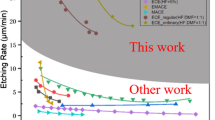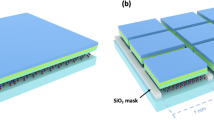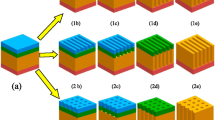Abstract
This paper presents a novel method to obtain structures with normative polygon cross section (PCS) shapes in a single crystal silicon substrate. A combination of wet etching and an after thermal oxidation (ATO) technique was used to fabricate several novel, complex structures with PCS shapes, which can hardly be fabricated by traditional wet etching. Based on such an innovative method, this paper proposes and develops three varieties of PCS silicon-beams. The subsequent experiment of fabricating silicon-beams with hexagonal sections has been taken as an example to validate the technique principle. Furthermore, the dimension parameters of the fabricated structures have been tested. Through this novel fabrication method, the sidewall arris of the fabricated silicon-beams can be maintained due to the protection of the ATO SiO2 layers, the arris disfigurement of the silicon-beam decreases dramatically and the quality of the silicon-beam is improved greatly.






Similar content being viewed by others
Abbreviations
- PCS:
-
Polygon cross section
- ATO:
-
After thermal oxidation
References
Alves MAR, Takeuti DF, Braga ES (2005) Fabrication of sharp silicon tips employing anisotropic wet etching and reactive ion etching. Microelectron J 36:51–54
Andersson GI, Hedenstierna N, Sevnsson P, Pettersson H (1999) A novel silicon bulk gyroscope. Transducer ’99. http://citeseerx.ist.psu.edu/viewdoc/summary? doi:10.1.1.199.8648
Archer MJ, Ligler FS (2008) Fabrication and characterization of silicon micro-funnels and tapered micro-channels for stochastic sensing applications. Sensors 8:3848–3872. doi:10.3390/s8063848
Brugger J, Beljakovic G, Despont M, Rooij NF, Vettiger P (1997) Silicon micro/nanomechanical device fabrication based on focused ion beam surface modification and KOH etching. Microelectron Eng 35:401–404
Canavese G, Marasso SL, Quaglio M, Cocuzza M, Ricciardi C, Pirri CF (2007) Polymeric mask protection for alternative KOH silicon wet etching. J Micromech Microeng 17:1387–1393. doi:10.1088/0960-1317/17/7/022
Chae J, Kulah K, Najafi K (2003) A monolithic three-axis silicon capacitive accelerometer with micro-g resolution. Transducer ’03. http://ieeexplore.ieee.org/xpls/abs_all.jsp?arnumber=1215258
Hsu TR (2002) MEMS and Microsystem: design and manufacture. McGraw-Hill Science, Boston
Kovacs GTA, Maluf NI, Petersen KE (1998) Bulk micromachining of silicon. Proc IEEE 86:1536–1551
Mirabella DA, Suárez MP, Aldao CM (2009) Hillock sizes after wet etching in silicon. Surf Sci 603:3346–3349
Rödjegård H, Andersson GI, Rusu C, Löfgren M, Billger D (2005) Capacitive slanted-beam three-axis accelerometer: I. Model Des 15:1989–1995. doi:10.1088/0960-1317/15/11/001
Rouhi J, Mahmud S, Hutagalung SD, Naderi N, Kakooei S, Abdullah MJ (2012) Controlling the shape and gap width of silicon electrodes using local anodic oxidation and anisotropic TMAH wet etching. Semicond Sci Technol 27:1–11. doi:10.1088/0268-1242/27/6/065001
Sarajlic E, Yamahata C, Fujita H (2007) Towards wet anisotropic silicon etching of perfect pyramidal pits. Microelectron Eng 84:1419–1422
Schmidt B, Bischoff L, Teichert J (1997) Writing FIB implantation and subsequent anisotropic wet chemical etching for fabrication of 3D structure in silicon. Sens Actuat A 61:369–373
Walczak R, Dziuban J (2006) Fast wet anisotropic etching of silicon utilizing microwave treatment of KOH etchant. Meas Sci Technol 17:38–44. doi:10.1088/0957-0233/17/1/008
XinXin L, Takahito O, Yuelin W, Masayoshi E (2002) Study on ultra-thin NEMS cantilevers-high yield fabrication and size effect on young’s modulus of silicon. IEEE MEMS ’2002. http://ieeexplore.ieee.org/xpls/abs_all.jsp?arnumber=984294&tag=1
Xiong W, Dingbang X, Zelong Z, Zhihua C, Xuezhong W, Shengyi L (2011) Support loss for beam undergoing coupled vibration of bending and torsion in rocking mass resonator. Sens Actuat A 171:199–206
Zhanqiang H, Dingbang X, Xuezhong W, Peitao D, Zhihua C, Zhengyi N, Xu Z (2011) Effect of axial force on the performance of micromachined vibratory rate gyroscopes Sensors. Sensors 11:296–309. doi:10.3390/s110100296
Acknowledgments
This work was supported by the National Natural Science Foundation of China (NSFC, Grant No. 51175506 and 51005239), and carried out at the Microsystem Laboratory, College of Mechanical Engineering and Automation, National University of Defense Technology. Especially, the authors are grateful to Xu Zhang, Xiaoshuang Guo and Tongzhi Zhou for their help in device fabrication.
Author information
Authors and Affiliations
Corresponding author
Rights and permissions
About this article
Cite this article
Xiao, D., Wang, X., Zhou, Z. et al. A novel fabrication method based on an after thermal oxidation process for the realization of silicon-beams with normative polygon cross sections shapes. Microsyst Technol 19, 1081–1086 (2013). https://doi.org/10.1007/s00542-012-1704-9
Received:
Accepted:
Published:
Issue Date:
DOI: https://doi.org/10.1007/s00542-012-1704-9




